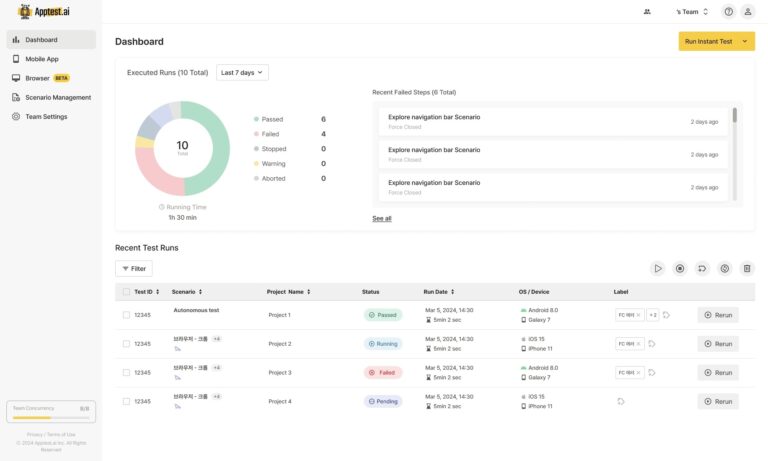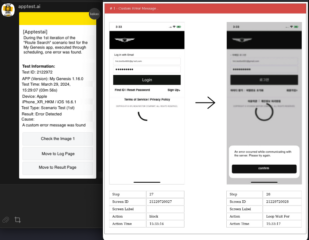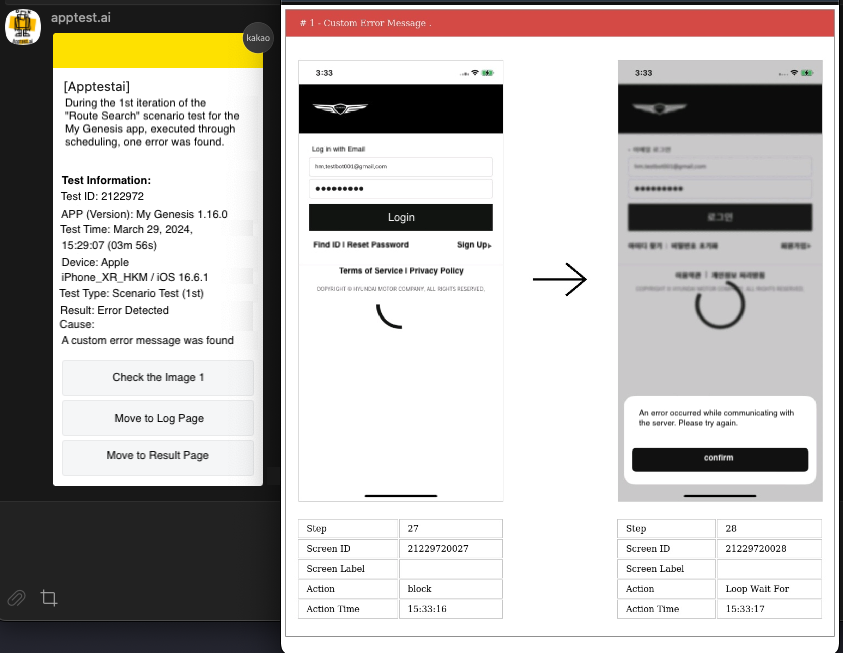
AI-Powered Test Automation Cloud
Ptero (pronounced “Tero”) is a comprehensive cloud-based test automation platform that integrates a Web Client, an AI Testbot (Test Engine + AI Engine), and a real-device Device Farm. It helps teams streamline testing workflows, improve quality assurance, and support autonomous UI-based exploratory and scenario testing. With Ptero, teams can manage every test in one place and deliver consistent, reliable, and scalable results.

100% Coverage with Two Methods
Overview of Our Testing Services
Apptest.ai provides AI-powered UI testing designed to reflect real user experiences.
Using two testing methods, Ptero delivers full coverage, faster validation, and more reliable releases.
Autonomous Exploratory Testing
The AI Testbot automatically explores your app to detect crashes and stability issues through black-box testing. It also finds issues early without predefined scripts or maintenance effort, helping QA teams deliver smoother releases.
-
Automated UI Testing
-
Stability Verification
-
Zero Maintenance Effort
Scenario Testing
This method uses Stego to create and run codeless scenarios that verify app features and user flows. It helps teams test app functionality faster and more consistently without writing a single line of code.
-
Functional Automation
-
Easy Scenario Management
-
Cost and Time Efficiency
100% Coverage with Two Methods
Core Components of Ptero
Ptero combines the AI Testbot, Web Client, and Device Farm into one unified test automation platform. Together, they enable a seamless and efficient testing experience.
AI Engine + Test Engine
AI Testbot
The AI Testbot applies deep learning technologies like Object Detection and OCR to analyze app screens. It generates and executes test scenarios automatically, helping teams validate app stability and functionality with confidence.
Easy and Intuitive
Web Client
The Web Client offers an intuitive dashboard that visualizes test results clearly.
Teams can easily monitor progress, analyze errors, and manage tests using visual charts and detailed reports.
Real Devices
Device Farm
The Device Farm allows testing on real Android and iOS devices without physical setup.
Teams can also deploy on-premises to maintain secure and scalable testing environments.
-
Provides error tracking, performance insights, and easy result
Premium Test Report -
Real-time Error Alerts
Error Notification Service

The Premium Test Report provides detailed performance and error insights, including CPU and network profiling. It visualizes detected errors with screenshots, device logs, and paths, helping teams resolve issues faster. Shareable links make it easy to review and communicate results across teams.

The Error Notification Service instantly alerts teams when issues appear after testing. Notifications can be sent through messengers, collaboration tools, or email, allowing faster responses and improved efficiency.

The Premium Test Report provides detailed performance and error insights, including CPU and network profiling. It visualizes detected errors with screenshots, device logs, and execution paths, helping teams resolve issues quickly. Furthermore, shareable links make reviewing and communicating results easier across teams.

The Error Notification Service instantly alerts teams when issues appear after testing. Notifications can be sent through messengers, collaboration tools, or email, allowing faster responses and improved efficiency.